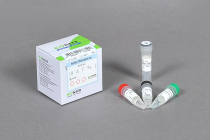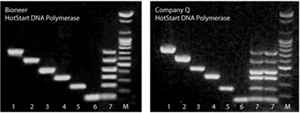We use cookies to give you the best online experience. By using our website you agree to our use of cookies in accordance with our Cookie Policy
HotStart DNA Polymerase

HotStart DNA polymerase inhibits PCR by using pyrophosphate (PPi) to trap Mg2+ ions essential for PCR, then breaking the PPi down by using heat resistant enzyme pyrophosphatase (PPase) as the temperature increases while processing the PCR reaction
※This product is shipped in dry ice.
▶ Principles of HotStart DNA Polymerase

While divalent cation magnesium (Mg2+) plays an important role in PCR, the pyrophosphate binds with Mg2+ to form a complex that inhibits the PCR.
However, the Mg-PPi complex will decompose into Mg2+ and 2Pi by the thermostable pyrophosphatase (PPase) during the PCR reaction, allowing increased reactivity with the by-product of the digested PPi, 2Pi.
Features and Benefits
- Sensitivity & specificity
Reduced generation of non-specific responses and primer-dimer formation during the mixing of PCR components by inhibiting DNA polymerase activity at the room temperature
- Efficiency
Improved yield of target DNA through its high sensitivity and specificity
- Reproducibility
Reproducible results with uniform quality products for each batch under the ISO 9001 quality system
Application
- HotStart PCR, PCR with complex genomic templates/low copy templates/cDNA
- Multiplex PCR
- Primer extension
- SNP typing
- Real-time PCR using dsDNA Binding dye
- Multiple primer pairs and amplification of low copy template DNA
Experimental data

Figure. Multiplex PCR comparison of genomic DNA using 6 sets of primers.
Lane M : 100 bp DNA Ladder (Bioneer, Cat. No. D-1030)
Lane 1 : 750 bp fragment
Lane 2 : 590 bp fragment
Lane 3 : 450 bp fragment
Lane 4 : 360 bp fragment
Lane 5 : 260 bp fragment
Lane 6 : 150 bp fragment
Lane 7 : Multiplex PCR with primers used for Lane 1 – 6





